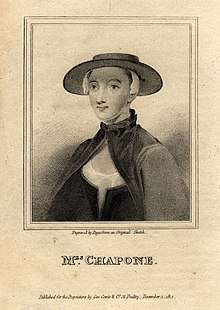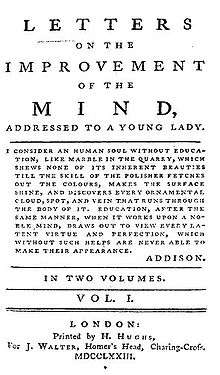Hester Chapone
Hester Chapone, née Mulso (27 October 1727, Twywell, Northamptonshire – 1801), was an English writer of conduct books for women. She became associated with the London Bluestockings.
| Hester Chapone | |
|---|---|
 | |
| Born | 1727 Twywell |
| Died | 1801 |
| Occupation | Writer |
| Spouse(s) | John Chapone |
| Parent(s) |
|
| Family | Thomas Mulso, Rev. John Mulso |
Life
The daughter of Thomas Mulso (1695–1763), a gentleman farmer, and his wife (died 1747/8), a daughter of Colonel Thomas, Hester wrote a romance at the age of nine, "The Loves of Amoret and Melissa", which earned her mother's disapproval. She was educated more thoroughly than most girls in that period, learning French, Italian and Latin, and began writing regularly and corresponding with other writers at the age of 18. Her earliest published works were four brief pieces written for Samuel Johnson's journal The Rambler in 1750.[1] She was married in 1760 to the solicitor John Chapone (c.1728–1761), who was the son of an earlier moral writer, Sarah Chapone (1699–1764), but soon widowed. Hester Chapone was associated with the learned ladies or Bluestockings who gathered around Elizabeth Montagu, and was the author of Letters on the Improvement of the Mind and Miscellanies. She died at Hadley, Middlesex, on 25 December 1801.[2]
Conduct books

The former was first written for her 15-year-old niece, in 1773, but by 1800 it had been through at least 16 editions. A further 12 editions had appeared by 1829, at least one of them a French translation. They focused on encouraging rational understanding through the reading of the Bible, history and literature. The girl addressed was also supposed to study book-keeping, household management and botany, geology, astronomy. Only sentimental novels were to be avoided. Mary Wollstonecraft singled it out as one of few examples of the self-improvement genre that deserved praise.
The tide of advice or conduct books in Britain reached its height between 1760 and 1820; one scholar calls the period as "the age of courtesy books for women".[3] As Nancy Armstrong writes in her seminal Desire and Domestic Fiction (1987): "So popular did these books become that by the second half of the eighteenth century virtually everyone knew the ideal of womanhood they proposed."[4] Chapone's is a typical example.[5]
Conduct books integrated the styles and rhetoric of earlier genres, such as devotional writings, marriage manuals, recipe books, and works on household economy. They offered their readers a description most often of the ideal woman, while at the same time handing out practical advice. Not only did they dictate morality, but they guided readers' choice of dress and outlined what was seen in that period as proper etiquette.[6] Chapone's work in particular appealed to Wollstonecraft and influenced her composition of Thoughts. She admired it for its "sustained programme of study for women" and basis on the idea that Christianity should be "the chief instructor of our rational faculties".[7] and on its emphasis that women should be considered rational beings and not left to wallow in "sensualism".[8] Wollstonecraft drew on both Chapone and Macaulay's works when she wrote A Vindication of the Rights of Woman in 1792.[9] Another admirer, and also a personal friend, was the novelist and diarist Frances Burney. Their surviving correspondence includes a letter of condolence of 4 April 1799 from Burney to Chapone, on the death in childbirth of Jane Jeffreyes, née Mulso, the niece to whom the Letters on the Improvement of the Mind had been addressed.[10]
Cultural influence
The 19th-century novelist Elizabeth Gaskell refers to Chapone as an epistolatory model, bracketing her in Cranford with Elizabeth Carter, a much better educated Bluestocking.[11] The book is also mentioned in Anne Brontë's novel Agnes Grey through one of the characters, and it had an influence on Samuel Richardson, Jane Austen and Mary Wollstonecraft.[12]
In Chapter 1 of Vanity Fair, Thackeray neatly sums up the self-image of Miss Pinkerton, proprietor of an "academy for young ladies", by describing her as "that majestic lady; the Semiramis of Hammersmith, the friend of Doctor Johnson, the correspondent of Mrs. Chapone herself"; later in the same chapter Miss Pinkerton notes that her establishment, The Mall, enjoyed "the patronage of the admirable Mrs Chapone".
Richardson and Elizabeth Carter edited a posthumous compilation of Chapone's writings entitled "The Posthumous Works of Mrs. Chapone: Containing Her Correspondence with Mr. Richardson; a Series of Letters to Mrs. Elizabeth Carter, and Some Fugitive Pieces, Never Before Published. Together with an Account of Her Life and Character, Drawn Up by Her Own Family" (1807). There, Chapone is quoted:
"Though men's ways are unequal, the ways of God are equal, and with him even women shall find justice."
Notes
- ODNB entries for Hester Chapone and Sarah Chapone . Retrieved 3 August 2011, pay-walled.
- ODNB entry for Hester Chapone.
- Quoted in Armstrong, p. 61.
- Armstrong, p. 61.
- Sutherland, pp. 28 and 35.
- Sutherland, p. 26.
- Sutherland, p. 29,
- Sutherland, p. 41.
- Sutherland, pp. 42–43.
- The Journals and Letters of Fanny Burney (Madame D'Arblay). Volume 4, 1797–1801. Edited by Joyce Hemlow, et al. (London: Oxford University Press, 1973), p. 271.
- Cranford, CHAPTER V—OLD LETTERS
- Adachi Michiyo. Agnes Grey As a Conduct Book Archived 15 September 2012 at the Wayback Machine
Bibliography
- Nancy Armstrong, Desire and Domestic Fiction: A Political History of the Novel. Oxford: Oxford University Press, 1987. ISBN 0-19-506160-8
- Elizabeth Eger and Lucy Peltz, Brilliant Women: 18th-Century Bluestockings, National Portrait Gallery, London, 2008
- Kathryn Sutherland, "Writings on Education and Conduct: Arguments for Female Improvement". Women and Literature in Britain 1700–1800. Ed. Vivien Jones. Cambridge: Cambridge University Press, 2000. ISBN 0-521-58680-1
- Barbara Eaton, Yes Papa!: Mrs Chapone and the bluestocking circle; a biography of Hester Mulso – Mrs Chapone (1727–1801), a bluestocking, London: Francis Boutle Publishers, 2012, ISBN 978-1-903427-70-5
- Biography in Dictionary of National Biography
External links
| Wikiquote has quotations related to: Hester Chapone |
- Hester Chapone at the Eighteenth-Century Poetry Archive (ECPA)
- Works by Hester Chapone at Project Gutenberg
- Works by or about Hester Chapone at Internet Archive
![]()